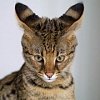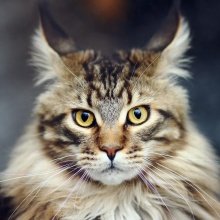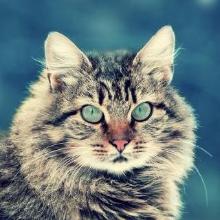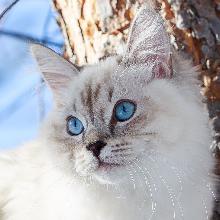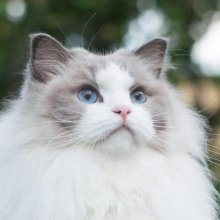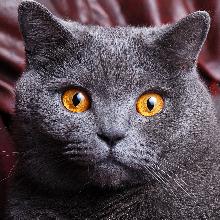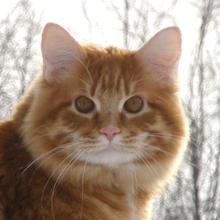The Biggest Cats
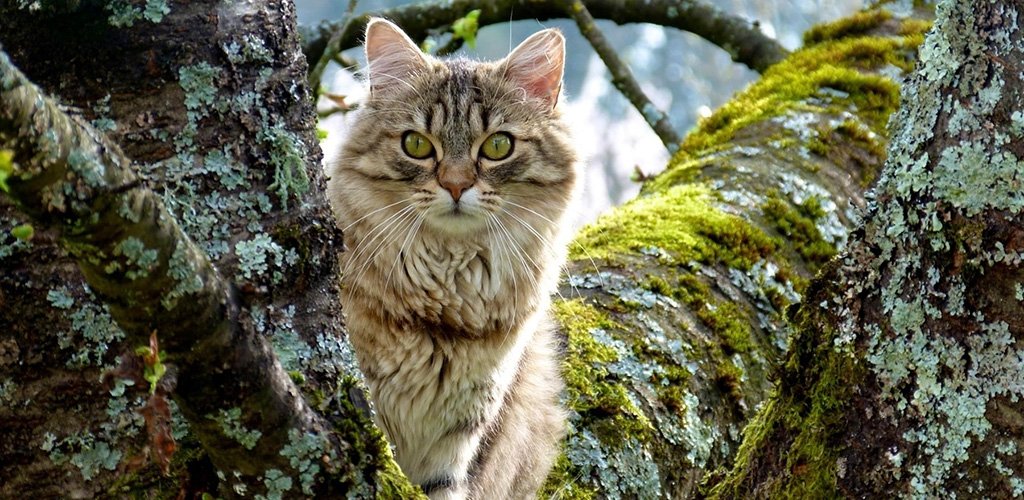
If a large dog causes respect and even fear, then a huge domestic cat amazes, it is invariably accompanied by admiring glances. No wonder large cats were kept at the courts of kings and sultans. Bas-reliefs of stately leopards and lions that lived in the gardens of the Pharaohs have been preserved on the walls of ancient temples in Egypt, and one of the most revered goddesses of the pantheon of ancient Egyptians was depicted as a big cat. The fashion for large representatives of the cat tribe has survived to the present day. Thanks to the skillful selection and painstaking work of professional felinologists, today everyone can get a luxurious pet that has the appearance of a wild animal, but has a fairly docile, and sometimes even too good-natured character.
Top 10 Biggest Cats
Among the representatives of the largest breeds of domestic cats there are long-legged lean shorthair beauties and shaggy bumpkins of a somewhat robber kind. The giants of the domesticated representatives of the feline world, whose weight reaches fifteen kilograms, or even more, include individuals of only a few breeds, and their prices sometimes go through the roof. Pets weighing from 7 to 12 kg are not so rare, but they look no less impressive and respectable.
It is worth saying that cats, invariably included in the rating of the largest, are mainly distinguished by their physique – a solid backbone, powerful musculature, and not at all by how well they are fattened by their adoring owners. All, without exception, mustachioed giants reach their heyday only by the age of 3-4, and it is at this age that their individual weight is established. Males are overwhelmingly much larger than females. Depending on the breed and litter, the difference in weight between them varies and can range from three to five to six kilograms.
1. Savannah
Savannah , the largest domestic cat on the planet, belongs to the rarest, most expensive, exotic and young breeds. Breeding work on its breeding began in the 80s of the last century and took place in stages. In fact, the savanna is a hybrid of a domestic cat and an African serval – a predatory mammal, a close relative of the lynx and the caracal, but its color is more like a cheetah. Her homeland is the USA, or rather, one of the farms of the state of Pennsylvania, where, as a result of crossing a serval and a domestic Siamese cat, a female was born, which was named Savannah – it was she who became the ancestor of a new breed. Later, breeders connected Bengal cats, Egyptian Mau, ocikets to the breeding process. The breed standard was officially approved in 2001.
Savanna is a magnificent strong animal, whose weight reaches 15 kg, and sometimes exceeds this figure. The length of the cat's body is about a meter, and the height at the withers is about half a meter. Distinctive features of her appearance are an elongated neck, a nobly planted head, tall slender limbs, thick fur, large ears.
Despite the fact that Savannah's gaze is wild and, one might even say, unkind, she is not aggressive at all. This cat is quite sociable, friendly to children, devoted to the owner, perfectly, like a dog, understands commands and is ready to walk on a leash without whims. However, in urban conditions, savannah experiences discomfort, as it needs an active lifestyle. She should be able to realize her instincts: climb to a height, hunt, jump, demonstrating the wonders of balancing – from a place this pet may well "jump" 3.5 meters vertically. Savannas are not afraid of water at all, on the contrary, they are not averse to swimming a fairly decent distance.
Not all savannas are the same: their size and habits depend on the degree of kinship with their wild ancestor – serval. The cats designated as F1 hybrid are the least distant from the serval. These are the heirs of the first generation of animal mating – wild and domestic. They are the largest, rare and, accordingly, expensive. The higher the number after F, the less serval blood savannah has. The animals of the F7 hybrid, for example, are similar in build and size to an ordinary domestic cat. Savannah kittens can cost from $4,000 to $20,000.
In 2006, representatives of the company "LifestylePets" announced the appearance of a new breed of cats – Usher. These animals appeared as a result of a cross between a Bengal cat, an Asian leopard cat and a serval. Initially, the cost of a kitten in the kennel was 20 thousand dollars, but despite this, Asher quickly gained popularity. Soon, however, it turned out that the DNA of these feline representatives is identical to the DNA of savannahs, so this breed is not recognized today as a separate one. However, these exotic-looking cats remain very popular, besides the cost of them has significantly decreased.
2. Maine Coon
The second place in the list of the biggest cats is occupied by maine coons . The Maine Coon giant cats became known in the middle of the XIX century, when they began to be shown at fairs held in the northeastern American state of Maine. There are still popular legends that Maine coons appeared as a result of crossing domestic cats and wild animals, among which they call a raccoon and a lynx. The Maine Coon allegedly inherited its tail with a distinctive color from the raccoon, and charming tassels on the ears from the lynx. These spectacular versions are beautiful, but from the point of view of genetics they do not stand up to criticism. Dog handlers are sure that the breed was formed independently, as a result of natural evolution, but is intraspecific.
Maine Coons reach their maturity by the fourth year of life. At this age, their weight can be 12-15 kg. They have a large and long body, a powerful chest, well-developed muscles, thick, strong paws. In addition to their power, Maine Coons can be proud of their luxurious thick fur. Another distinctive feature of the appearance of this animal is an incredibly fluffy tail, which the cat wraps up in the cold season.
Maine Coons have a great character - soft and accommodating. They are intelligent, intelligent, friendly, but they do not tolerate familiarity. These cats like to live in pairs. Male Maine Coons are great fathers who enthusiastically take part in the upbringing of their offspring on a par with females.
It is to the Maine Coon breed that the longest cat belongs. A male named Stu, a native of Nevada, is known for the fact that the distance from the tip of his nose to the tip of his tail was 1.23 m.
3. Chaouzi
Large, statuesque and elegant chausi belong to young breeds of cats. They were bred in the USA in the 60s of the last century, and registered only at the beginning of this year. The Chausi appeared due to the crossing of the Abyssinian domestic cat and the wild reed cat, also known as the marsh lynx.
Chausi are built athletically, they have a long body, and the height at the withers can reach 40 cm, which puts them in third place in our ranking of the biggest cats. The weight of an adult male reaches 14.5 kg . These amazing cats have a completely wild appearance. Their coloring, predatory gaze, hunting habits make you wonder if you should be afraid of them. But upon closer acquaintance, it turns out that chausie is the sweetest creature: affectionate, gentle, peaceful, loving to purr, and quite loudly.
From their predatory ancestors, these cats inherited a passion for hunting, a love of water and a desire to conquer heights. They like to stock up, often dragging unattended products from the kitchen. They should be fed with raw meat and fish, quail eggs, cereals are contraindicated for them.
Chausie is a very rare breed of cats, because it is quite difficult to breed them. The most popular chausies are in their homeland – in the USA, there are several nurseries in Europe. In the post-Soviet space, chausi are considered a rarity. The cost of a kitten of this breed can reach $ 10,000.
4. Siberian and Neva masquerade cats
Siberian cat is the pride of Russian breeders and the first domestic breed recognized by all international felinological organizations. The name of the breed, which began to be bred in the late 80s of the last century, is symbolic, since animals common throughout Russia, and not only Siberia, took part in the selection. The largest, strongest animals with heavy bones and thick long hair were selected for breeding. The result was excellent: the Siberian cat looks like a real taiga inhabitant: hardy, powerful, big, severe. The average weight of adult males is 10 kg, but 12–kilogram Siberians are not uncommon at all.
Siberian cats have a strong nervous system and high intelligence. They are calm, reasonable, patient with children, and they are attached to the owner like dogs. These cats are fearless and are excellent hunters.
The Siberian cat rightfully occupies the fourth place in our rating of big cats, and to it we will also add the Neva masquerade, which is considered its subspecies. The breeders of the Kotofey Club bred this magnificent breed under the guidance of felinologist Olga Mironova and presented it at her cat show in 1988. The Neva masquerade cat owes its name to the Neva River, on which St. Petersburg stands, and the color of the muzzle, similar to a carnival mask.
Today Siberian cats are bred in the USA, Canada, Great Britain, Germany, Spain, Italy, Finland and other countries. The number of nurseries located around the world is more than three hundred.
5. Ragdoll and ragamuffin
The top five of the rating of the biggest cats in the world are closing ragdolls together with their charming subspecies – ragamuffins. Ragamuffin, which means "ragamuffin" in English, is the creation of the creative American breeder Ann Baker, also known as the founder of the Ragdoll breed. Actually, ragamuffins are ragdolls crossed with yard mongrel cats. Their appearance is very similar to the appearance of ragdolls, but these adorable creatures have a richer palette of colors. Ragamuffins can be long-haired and short-haired.
Representatives of this breed have an elongated, strong, muscular body, by the age of four, the age of their full maturity, they can gain weight up to 10 kg. By nature, ragamuffins are similar to ragdolls: they are the same gentle, affectionate, in need of the love and attention of the owner, and, despite their impressive size, completely defenseless against the aggression of other animals.
The breed was introduced in 1994, but numerous detractors of Ann Baker for a long time prevented the official recognition of ragamuffins. Only in 2003, these cats received a separate status from ragdolls and were recognized by international cynological organizations.
6. Norwegian forest cat
Luxury Norwegian forest cats are the pride of the whole of Scandinavia, where they are considered native animals. Presumably, their long-time ancestors are long-haired representatives of the cat tribe brought to these harsh northern regions. As a result of natural selection and adaptation to the Scandinavian climate, they became the founders of a special population of cats – large, strong, distinguished by endurance and very thick fur. At the beginning of the last century, the Norwegian authorities granted official protection to aboriginal wildcats, obliging foresters and rangers in nature reserves to fight back against poachers who caught these beauties en masse and took them out of the country. In the 30s, breeders engaged in systematic breeding of Norwegian forest cats in order to avoid the disappearance of animals, and at the same time preserve their pristine beauty. Officially, the breed "Norwegian forest cat" was recognized only in 1977.
The Norwegian forest cat looks powerful but elegant. He has a strong elongated body, the hind limbs are noticeably longer than the front ones, which is more typical for a lynx than for a domestic cat. This proportion allows this animal to descend from a height head down in a spiral, like a squirrel, which is not typical of most pets. The weight of an adult male can reach 10 kg, but visually, thanks to its luxurious coat, it "pulls" a whole pood.
The character of the Norwegian is as magnificent as his appearance. He is an excellent and loyal companion, very inquisitive, sociable, but not annoying. The cat is exceptionally friendly and always ready to be friends with other pets.
In the second half of the last century, King Olaf V of Norway awarded the Norwegian forest cat the status of a national breed. In Western and Northern Europe, this charming animal has plenty of fans, in the USA they are not very popular, and in Russia there are only a few nurseries where you can buy a guaranteed thoroughbred kitten of a Norwegian forest cat. They operate in Moscow and St. Petersburg.
7. British shorthair cat
British Shorthair cat is one of the oldest and largest English breeds. The ancient ancestors of these animals are presumably cats brought to Britain by Roman legionnaires before our era. For centuries, they have interbred not only with each other, but also with aboriginal wildcats. The British shorthair cats as a breed became known in 1871, when they were presented at the London cat Show, after which they gained extreme popularity. However, at the beginning of the twentieth century, the fashion for these cats passed, and by the 50s their population had significantly decreased. To preserve the breed, breeders began to cross a few representatives of British shorthair with Persian cats, as a result of which these cats look a little different today than a century and a half ago.
The Briton is a large, but quite compact in his constitution, a sturdy man who, thanks to his superbly sculpted musculature and unusual plush wool, looks even more powerful than he really is. On average, adult cats weigh up to 9 kg, but the weight of some pets reaches 12 kg. This is usually due to the fact that representatives of this breed are prone to obesity, because they become inactive with age. By their nature, British shorthair cats are calm and independent, they treat others selectively, and they do not let strangers near them at all.
There is an opinion that the illustrations for the book "Alice in Wonderland", created by the English artist John Tenniel, depict a British shorthair cat. Today, the Briton is the recognizable "face" of the Whiskas brand.
8. Pixiebob
The breed known today as pixiebob , was originally formed in the process of crossing in natural conditions of a domestic cat and a bobcat – a wild lynx. Due to the fact that these animals have the same karyotype, their offspring turned out to be fertile. In the 80s of the last century, American felinologists, having caught three wild individuals in the forest, began their reproduction, trying to preserve the pristine appearance of the animal. In 1998, the new breed received the right to participate in the championships of the world's largest felinological organization TICA.
Outwardly, the pixybob resembles a small lynx with a short tail. He has a powerful body, strong paws, a wild, slightly gloomy look. The weight of an adult pet is 7-9 kg. Despite its harsh and menacing appearance, the pixybob is a fairly peaceful, calm creature. He is not aggressive, rarely releases his claws, he will not bite a person in full force. With their behavior and devotion, these cats resemble dogs. Pixybobs don't meow, but when they play with each other, they growl. Their purring is not like the songs of domestic cats – it is very loud and heavy. These animals do not welcome other pets, but they do not enter into conflicts with the four–legged brothers - they just keep their distance.
The offspring of pixybobs give a small number – there are usually 2-3 kittens in the litter. This rare breed is recognized as a national treasure of the United States. Official permission is required to export cats from the country.
9. Turkish Van
Ancestors turkish van - aboriginal semi-long-haired cats that have lived since time immemorial in the area adjacent to Lake Van, located on the territory of Turkey. This breed was discovered to the modern world by British journalist Laura Lashington, a big fan of cats. From her trips to this region of Turkey in the 50s of the last century, she brought charming kittens several times, from which the breeding of the Turkish Van cat breed in Europe began. To date, the Turkish van is recognized by all leading felinological international organizations.
An adult Turkish Van cat can weigh up to 9 kg. His body is muscular, long, with a wide powerful chest. These pets are very fond of water fun and swim well. They are very active, sociable, overly inquisitive and emotional. They have a well-developed hunting instinct. In childhood and at a young age, these kitties can even show some aggressiveness, biting and scratching their owners. However, with age, their character becomes softer.
In Turkey, the indigenous Van cats (they are called van kedisi here) are very revered, are one of the symbols of the country and are listed in the Red Book. They are credited with the gift of bringing happiness and good luck, these animals are even allowed to enter the mosque. It is possible to export Turkish vans from the country only with an official permit.
10. Chartreuse
Chartreuse , or Cartesian, as well as medieval cat, is considered a French breed. However, historians in the field of felinology are sure that the ancestors of Chartreuse are cats brought to France from the East during the Crusades. In the XVI century, they were described as stocky animals having a gray-ash color with a blue tint. Initially, these big cats lived at the main monastery of the Carthusian order of the Grand Chartreuse, but over time they bred in other regions of the country. After the First World War, French breeders began systematic breeding of the breed, and in 1928 Chartreuse already took part in exhibitions. Today, chartreuse breeding nurseries are mainly located in France and the USA.
With their appearance, chartreuse resemble British shorthair cats, but they have a different constitution and lack the pronounced plush wool characteristic of the British. When looking at their dense, downed, compact body and short limbs, it may seem that these pets are lightweight, however, lifting chartreuse in your arms, you will immediately realize how deceptive this impression is. Adult chartreuse have a significant muscle mass and can weigh up to 7 kg. They are very balanced and measured, one might say even phlegmatic. They seem to enjoy watching more than acting. Chartreuse very rarely meow, and their voice is so quiet that it looks like a whisper.
It is difficult to find purebred Chartreuse in Russia. Often, even in nurseries called "chartreuse", short-haired blue cats of British breed, European short-haired blue cats or hybrids of these breeds are sold. You can buy a guaranteed purebred kitten in clubs belonging to the international felinological organization FIFe.
More cats not included in the rating
In addition to the breeds listed above, the following representatives of the whiskered-striped ones can boast of large sizes:
